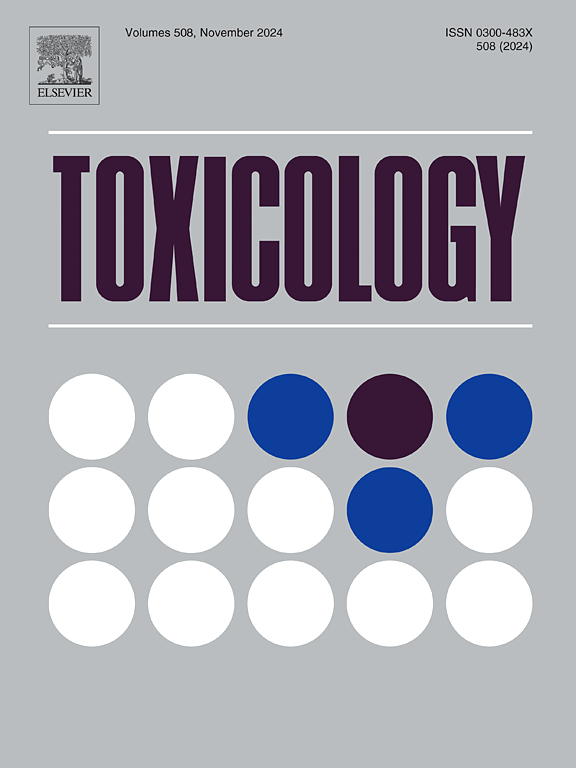Prepubertal exposure to gadolinium-based contrast agents impairs sperm quality and elevates oxidative stress in adult rats
IF 4.6
3区 医学
Q1 PHARMACOLOGY & PHARMACY
引用次数: 0
Abstract
Gadolinium-based contrast agents (GBCAs) are widely used in magnetic resonance imaging. Gadolinium (Gd) retention has been reported in various tissues of both patients and experimental animals, even in those with normal renal and hepatic function and an intact blood-brain barrier. Gadoteric Acid (Dotarem®) is approved for use in children of all ages, including neonates. In these groups, the blood-tissue barriers in the male reproductive tract are still developing, which may lead to more pronounced Gd retention than in adults. The aim of this study was to evaluate the effects of a single prepubertal exposure (15 days postnatal, pnd) to gadoteric acid (Gadoterate meglumine - Dotarem®) on sperm quality and quantity in adult rats. Male rats were treated with a single dose of gadoteric acid at a clinical-equivalent dose (0.6 mMol/kg) or at one-tenth that dose (0.06 mMol/kg), at 15pnd (prepubertal phase). The rats were euthanized at 110pnd (adult phase). Gd-treated animals exhibited reduced testicular and epididymal weights, decrease daily sperm production, and increased epididymal sperm transit time. Sperm motility, viability, morphology, mitochondrial function, acrosomal and DNA integrity, and chromatin compaction were also negatively affected. Furthermore, increased oxidative stress markers and lipid peroxidation were observed in sperm and testicular tissue. A single prepubertal exposure to Gd, before the establishment of testicular and epididymal barriers, may lead to long-term alterations in sperm quantitative and qualitative parameters and induce oxidative stress in sperm and male reproductive tissues in adulthood.
在成年大鼠中,青春期前暴露于钆造影剂会损害精子质量并升高氧化应激
钆基造影剂(GBCAs)广泛应用于磁共振成像。钆(Gd)潴留已被报道在患者和实验动物的各种组织中,甚至在那些肾功能和肝功能正常且血脑屏障完整的组织中。gadoteracid (Dotarem®)被批准用于所有年龄段的儿童,包括新生儿。在这些群体中,男性生殖道中的血液组织屏障仍在发育,这可能导致比成人更明显的Gd潴留。本研究的目的是评估单次青春期前(出生后15天,pnd)暴露于Gadoterate meglumine - Dotarem®对成年大鼠精子质量和数量的影响。雄性大鼠在15pnd(青春期前)以临床等效剂量(0.6 mMol/kg)或十分之一剂量(0.06 mMol/kg)给予单剂量的钆酸治疗。大鼠于成虫期110磅时安乐死。gd处理的动物表现出睾丸和附睾重量减少,每日精子产量减少,附睾精子传递时间增加。精子活力、活力、形态、线粒体功能、顶体和DNA完整性以及染色质压实度也受到负面影响。此外,精子和睾丸组织中氧化应激标志物和脂质过氧化水平升高。在睾丸和附睾屏障建立之前,青春期前单次暴露于Gd可能导致精子定量和定性参数的长期改变,并在成年期诱导精子和男性生殖组织的氧化应激。
本文章由计算机程序翻译,如有差异,请以英文原文为准。
求助全文
约1分钟内获得全文
求助全文
来源期刊

Toxicology
医学-毒理学
CiteScore
7.80
自引率
4.40%
发文量
222
审稿时长
23 days
期刊介绍:
Toxicology is an international, peer-reviewed journal that publishes only the highest quality original scientific research and critical reviews describing hypothesis-based investigations into mechanisms of toxicity associated with exposures to xenobiotic chemicals, particularly as it relates to human health. In this respect "mechanisms" is defined on both the macro (e.g. physiological, biological, kinetic, species, sex, etc.) and molecular (genomic, transcriptomic, metabolic, etc.) scale. Emphasis is placed on findings that identify novel hazards and that can be extrapolated to exposures and mechanisms that are relevant to estimating human risk. Toxicology also publishes brief communications, personal commentaries and opinion articles, as well as concise expert reviews on contemporary topics. All research and review articles published in Toxicology are subject to rigorous peer review. Authors are asked to contact the Editor-in-Chief prior to submitting review articles or commentaries for consideration for publication in Toxicology.
 求助内容:
求助内容: 应助结果提醒方式:
应助结果提醒方式:


